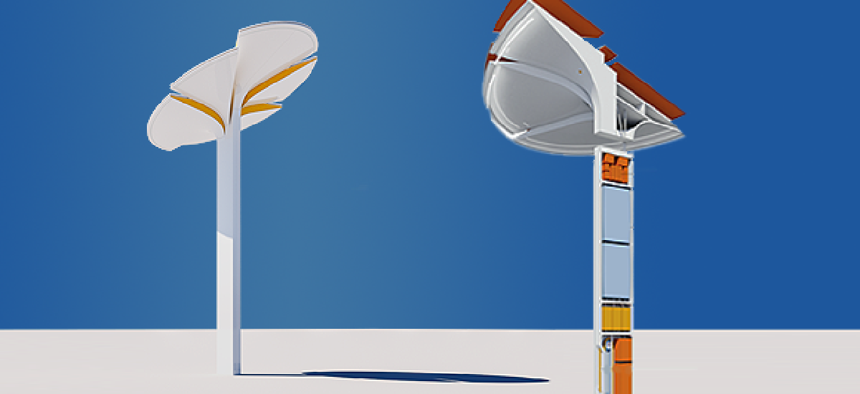A smart city power platform blooms

Totem Power’s tower features a flower-shaped canopy that houses a solar array to power the lights, communications hub and electric vehicle charging station in the stem.
The next energy platform for smart cites may look like a giant flower.
The brainchild of Totem Power, the tower features a flower-shaped canopy that houses the Totem’s solar array. Lights, a Wi-Fi and 4G communications hub, batteries and electric vehicle charging station are in the stem.
The design of the product was important, said CEO and founder Brian Lakamp. “It’s a lot more than just making it look cool, although I’m happy to say that that is a side [benefit],” he told GCN. Electricity infrastructure is usually hidden underground or parking garages and alleyways, but it’s important for people to see and to talk about, he said.
“By taking this type of infrastructure from the back of building to the front of the building there is an opportunity to tell stories,” Lakamp explained. “The minute you start looking at a product as a vehicle for storytelling and understanding, design becomes very important.”
This conversation is important, he said, because there is an opportunity to change utility and power generation. A vital part of that will be batteries like the ones housed in Totem’s towers. Batteries make solar energy generation more practical; they allow energy to be stored and used later during peak usage times or if the grid goes down.
This platform isn’t meant to generate power for an entire city, though it will be connected to the energy grid. It’s meant to power other functionality within the tower like Wi-Fi, 4G (possibly 5G in the future), charging for electric vehicles and lighting. Although some of these are capabilities are offered by LinkNYC and similar smart kiosks, Lakamp said those projects fall short in what they could offer: “We think starting with a battery and on-deck [power] generation is really important.”
The target audience for this technology, which is expected to roll out in 2017, will be retail areas and business parks, Lakamp said. But the company plans on working with cities to develop smart city strategies and will be working closely with utilities as well.
The Totem technology offers a “long, long runway” for future uses within the smart city space, he said. The combination of a powerful CPU, communications and a battery can lead to a lot of potential innovation -- just look at the revolution caused by mobile technology, he said.
As systems evolve “there is almost “limitless city capability and functionality that can be built on top of that platform.”





